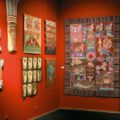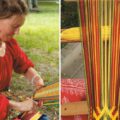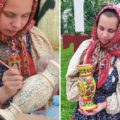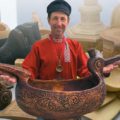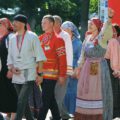One of the main themes of the Year of the Cultural Heritage of the Peoples of Russia is the preservation, promotion, and development of folk arts and crafts.
Polenov’s House as the Keeper of Traditions
A major role in this mission belongs to the Polenov State Russian House of Folk Art, the federal methodological center in the field of folk art.
Every year, there are dozens of all-Russian and interregional festivals as well as applied arts contests, in which professional artisans and amateur artists take part. This is the most massive and effective tool for the development of national crafts of the peoples of Russia.
The projects of the Polenov House cover various types of artistic activities and enable a wide range of events, including the All-Russian Festival of Decorative Arts “Patchwork Mosaic of Russia”, which has been held since 1997 in the city of Ivanovo, the textile capital of Russia. In addition to this, the city of Tver has been hosting the All-Russian exhibition “Potters of Russia” since 1997. Currently, it is the largest meeting of folk craftsmen and ceramic artists working with pottery and making clay toys. Annually, these and other projects bring together more than 1,500 talented artisans, as well as tens of thousands of viewers who gladly participate in exhibitions, master classes, and workshops.
Museums are also developing fast. The People’s Gallery of the Polenov House organizes stationary and travelling exhibitions, displaying unique works all over Russia. For instance, in 2020–2021, the “Doll in a Traditional Costume” exhibition, part of the All-Russian event, displayed 340 items from 58 regions.
Artisan Russia
The largest event among arts and crafts festivals is the All-Russian contest “Artisan Rus”, which was held for the 13th time in 2022.
In 2022, Kursk became the artisan capital of Russia. There, craftsmen from 28 Russian regions met from the 10th to the 12th of June.
The competition consists of several stages. The first one is qualifying, and it starts in municipalities and then in regions and republics, which select the best artisans who will ensure the best representation of their region. This year, the committee received 130 applications, of which the experts chose 60 finalists.
In 2001, Russia began to conduct the first competitions of folk craftsmen in separate categories, for instance, pottery in the city of Vologda and wood carving and painting in the region of Nizhny Novgorod. The idea of simultaneous contests in various crafts on the same site was implemented at regional competitions in Pskov, Tikhvin, Cheboksary, Irkutsk, Chelyabinsk, and other Russian cities.
The second stage is an open real-time competition: the participant should create a completely new product in eight hours. Each of the contestants acts as the keeper of a local craft tradition of the region.
The task becomes even more complicated since the topic is announced shortly before the contest. “The strength of the traditions of the peoples of Russia” is the slogan of 2022.
Olga Vasilyeva, from the city of Pskov and the winner in the nomination “Belt Weaving” says, “In my belt, all the patterns are intertwined, they transform from one into another, and this idea came right after the topic was announced. I started making the belt with the pattern of my Pskov region. This is the western shield of Russia. It is followed by the patterns of the Murmansk, Arkhangelsk, and Vologda regions, the Republic of Komi, Smolensk, Nizhny Novgorod, Kostroma, Altai, and Transbaikal.”
Irina Dolya, from the city of Lipetsk and the winner in the nomination “Patchwork”, says, “The strength of the traditions of the peoples of Russia implies that a tradition, like a thread in our traditional tambour embroidery, continuously connects the past with the future through the present.”
The contest was held in 12 nominations such as “Pottery”, “Clay toy”, “Painting on wood”, “Birch bark”, “Birch bark art”, “Belt weaving”, “Felt art”, “Cloth printing”, etc. The category “Textile Doll” had the largest number of contestants. Their craftsmanship was assessed by the jury — the experts in the field of arts and crafts as well as art historians.
Yuliya Privalova, Nizhny Novgorod Region, the winner in the nomination “Painting on wood” says, “For my work, I chose the traditional Polkhov-Maidan style and made a fairy tale about it. Polkhov-Maidan painting is our family craft: the men made and the women painted the items. It is a technologically difficult process. Before painting, one should apply primer and starch on the wooden pieces for three times. It takes almost a week. Then, an artisan makes a draft of the future painting with a pen on the primer. The next step is painting with aniline dyes, then shading (hatching) and varnishing.”
Twelve artisans won the contest in 2022, and wood carver Yuri Bezuglov from the city of Belgorod was one of them.
“First, I shape the ladle from a single piece of wood, make the bottom and check that it is level, then draw a center line and outline the contours. The ladle should have a rounded boat-like shape. After rough processing, I ensure that the ladle acquires a certain form and then apply the pattern on the product — geometric carving and solar symbols. During the finishing work, I cover the ladle with stain and oil. Like our ancestors, I use initial capitals in the design, which harmoniously fit into the geometric pattern,” Yuri Bezuglov commented on the process of creating the item.
The master’s works are in many collections. For instance, the Belgorod Museum of Folk Culture keeps the famous Utitsa skopkar ladle.
Today “Artisan Rus” is a large-scale festival that encourages the creativity of craftsmen from the most remote places of Russia. Several contests and exhibitions are held simultaneously within this project.
Since 2021, “Artisan Rus” is also conducted online, which enables to expand the geography of the contest and the list of nominations. Now the residents of the most remote towns and villages, who do not always have the opportunity to come to offline contests, can participate in it.
Regional projects
There is also a wide range of regional projects, for instance, “Artisan Far East” or “Artisan Ural”. Their aim is not only to assess skills, but also to form a professional community, to unite people, and to promote new ideas and methods. In 2021 alone, events under the Artisan Rus brand brought together over 300 craftsmen from all over the country.
As part of the Year of Cultural Heritage, the Polenov House is going to organize different projects in collaboration with regional centers of folk art. In August, the city of Kirov will host the 8th All-Russian Festival of Modern Handmade Toys of the Peoples of Russia, two exhibitions “The Art of Modern Handmade Toys”, and a thematic exhibition-contest “Soviet Era in a Modern Handmade Toy”. Visitors will see an amazing variety of clay, textile, wooden, and felt toys, as well as the ones made from plant materials, metal, and papier-mâché.
In October, the cities of Yaroslavl and Yoshkar-Ola will host the stages of the All-Russian Festival-Contest “National Costume of the Peoples of Russia”. This is not only a festival event, but also a highly respected research and methodological platform for artists, fashion designers, and researchers of traditional and modern national costume.
Craft as a value
New project “Golden Anthology of Folk Culture” will present folk crafts, and they will be included in the list of 100 masterpieces of the intangible heritage of the peoples of Russia.
Unique crafts have already been put in the Federal Register of Intangible Cultural Heritage, for example, Dobrovskaya clay toys in the Lipetsk region, Kirishi lace in the Leningrad region, Kadom Veniz embroidery in the Ryazan region, and the tradition of house carving in the Murom region of the Vladimir Oblast.
Tamara Purtova, the director of the Polenov House, Chairman of the Russian Committee for the Intangible Cultural Heritage of the Commission of the Russian Federation for UNESCO, member of the Organizing Committee of the Year of Cultural Heritage says,
“Interaction with folk crafts masters goes beyond contests and exhibitions. The experts of our House conduct systematic research and analytical work resulting in up-to-date projects. Considerable attention is paid to publishing activities. We annually publish collections of articles based on the results of conferences and round tables. The catalogs of exhibitions and contests expand the boundaries of the event, creating new opportunities for promotion and development of folk art. These publications not only describe the participants’ works, but also contain methodological and reference materials.”
The most important task that the Polenov House sets itself today, following in the footsteps of the great artist Vasily Polenov, whose name it bears, is increasing the qualifications and providing comprehensive methodological support for unique masters who preserve the multinational traditions of the peoples of Russia.
The Year of Cultural Heritage and the Day of Folk Artistic Crafts established by the President of Russia will become a new stage in the development of traditional arts and crafts and modern forms of its expression.
Mariya Yakunkina

